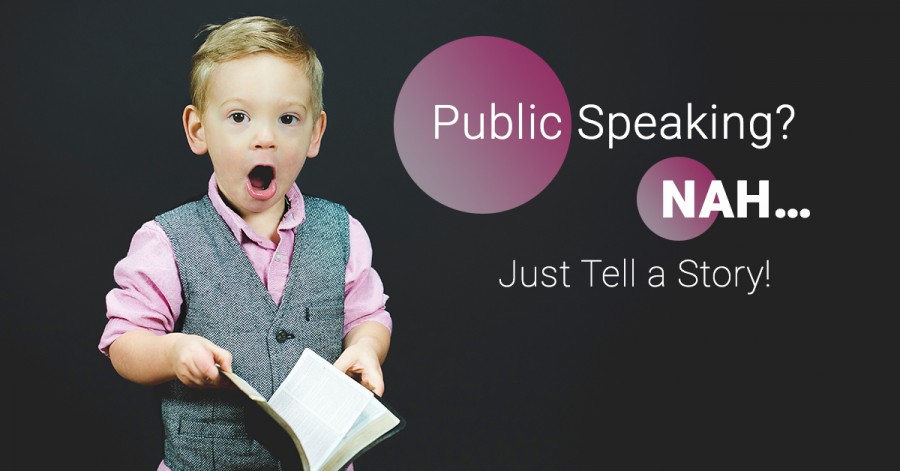Public Speaking? Nah… Just Tell a Story!
Published 20 October 2018 at 16:58
Tickikids Blog Hong Kong > digest > Public Speaking? Nah… Just Tell a Story!

I dedicate this article to my favourite age group – the youth of today. Much has been said and written about this topic and yet it remains an enigma to most of us when it really shouldn’t be. It should be as easy as it is for a 4-year-old to tell a story.

Photo Credit: pixabay.com
Recently I was invited to mentor a group of kids to improve their public speaking skills. These kids were going to present their project to a group of judges and the best idea was to win an award to fund their idea. I first asked them to tell me about their project. As they told me about why they chose the project, the passion, enthusiasm, and energy in their gestures and body language was apparent. Then I asked them to present their idea to me as they would to the judges. Suddenly the whole dynamic changed, the same bubbly bunch became uptight, nervous and robotic. When I asked them what the reason was, they said:
- It’s a formal presentation so we need to look and feel serious;
- It feels weird to stand on a stage in front of so many people and present;
- What if we make a mistake?
- What if we forget everything?
- What if people laugh at us?

Credit: photo by robinsonk26 on pixabay.com
When do we Public Speak?
It is a common misconception that only when we are standing on a stage in front of a large group of people with power points in the background and something very important to say to a bunch of very important people only then are we public speaking. Is that the only time we are speaking public? Think about the following situations:
- You are amongst a group of friends or peers or colleagues ;
- You have been invited to a party and you only know the host and nobody else;
- You are in a class lecture or a talk, and you want to ask a question.
To further elaborate on it, recently I went to a parent information evening. At the end of the talk, the speaker asked several times if anyone had any questions. Only about 3-4 questions came forth in a room full of people. What was interesting, was that a large group of people surrounded the speaker with their questions after the session had ended! These are only some examples of public speaking. There are many more occasions when we are public speaking, but we don’t realise it. The fears in each of these situations can be similar. And if we don’t get used to it, early on, it gets more and more difficult later in life.
![]()
Credit: photo by Rawpixel / Unsplash
How to make it easy till it becomes easy?
I share here some tips and techniques that have worked for my clients in becoming better at speaking in the public.
1. Tell a story. Whether you are speaking to a group of children or a bunch of adults, a story will stay with the listener long after the talk, presentation or conversation has ended. But the question that typically comes up is, how do you tell a story when making a formal presentation like in the case of these kids? Writing the timeline or sharing how you came up with the idea will get you going. Specifically, choosing the main characters and incidents from the timeline and putting it in form of a story is a good starting point. Once you have done that, see how you can add humour to it.
2. Body language, gestures, etc. When you are presenting something that resonates with you, you don’t really need to memorize it, because it is yours. Just to make sure you don’t miss out on any vital information, make cue cards to help you. Do not make a script and read out from it. You will have the audience sleeping in no time. When you are comfortable with your content, all the other elements (eye contact, gestures and body language, pace, voice projection) that public speaking gurus talk about, automatically come.
3. Know your fears. There are a lot of fears associated with Public Speaking. And rightly so. It leaves you vulnerable and open to judgment. Someone once said, “When I am on stage and everyone is staring at me, I feel naked.” And it is not an exaggeration.
I use a Coaching technique called “Downward Laddering “with my teen clients to bring them face-to-face with their fears. Here is how it works:
Ask yourself 2 questions:
1. What is the worst thing that can happen?
2. What will happen if that happens?
Keep asking yourself the 2 questions till you get to the bottom of it. 99% of the time my clients start laughing after only a few rounds because they can see clearly the silliness of their thought process and the fear soon disappears.

Credit: photo by Teemu Paananen / Unsplash
In Conclusion
Regardless of age, position or experience most people really don’t like speaking in public. We live in an age when students and employees are also judged on how well they communicate and present themselves at work and in public. It does not matter how good you really are, the knowledge you have or the expertise you have. If you cannot communicate it clearly, it is all lost. Despite that reality, many students leave school or university today with impressive qualifications yet when it comes to the spoken word a great number find themselves struggling to express themselves clearly and confidently. But with practice and right thought process, it can be overcome. As they say, “Catch them young!”. The sooner we start, the better we get.
By Shalini Bindal
You may like other articles of the author:
Is Your Child a Smartphone Addict?
Three Steps to becoming a "Listening" Parent
About the Author: Shalini Bindal is ICF-trained, Certified Professional Coach. She does personal and group coaching for Career Mums and Teens. Before becoming a Coach, she was an HR professional and Corporate Trainer. A mother of 2 teenagers, Shalini has lived in India, Belgium and currently in Hong Kong. Email her for a 45 minute free face-to-face or virtual session at shalini@kaleidoscope-workshops.com